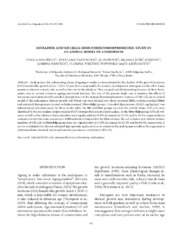Приказ основних података о документу
Estradiol and GH cells: Immunohistomorphometric study in an animal model of andropause
| dc.creator | Milošević, Verica | |
| dc.creator | Trifunović, Svetlana | |
| dc.creator | Filipović, Branko | |
| dc.creator | Šošić-Jurjević, Branka | |
| dc.creator | Živanović, Jasmina | |
| dc.creator | Perčinić-Popovska, Florina | |
| dc.creator | Ajdžanović, Vladimir | |
| dc.date.accessioned | 2015-08-28T10:26:51Z | |
| dc.date.available | 2015-08-28T10:26:51Z | |
| dc.date.issued | 2012 | sr |
| dc.date.issued | 2012 | |
| dc.identifier.issn | 0354-4664 | sr |
| dc.identifier.other | Rad_konverzija_364 | sr |
| dc.identifier.uri | https://radar.ibiss.bg.ac.rs/handle/123456789/305 | |
| dc.description.abstract | Andropause, the culminating phase of ageing in males is characterized by the decline of the growth hormone (GH)/insulin-like growth factor 1 (IGF-1) axis that is responsible for somatic development. Estrogens on the other hand, assume a relevant somatic role, as well as the one in the pituitary. They are particularly interesting because of their therapeutic uses in certain common ageing-associated diseases. The aim of the present study was to examine the effects of subcutaneous treatment with estradiol, dipropionate on the immunohistomorphometric features of GH cells, in an animal model of the andropause. Sixteen-month-old Wistar rats were divided into sham-operated (SO), orchidectomized (Orx) and estradiol dipropionate-treated orchidectomized (Orx+Edp) groups. Estradiol dipropionate (0.625 mg/kg/day) was administered subcutaneously for three weeks while the SO and Orx groups received the vehicle alone. GH cells were identified by the peroxidase-antiperoxidase (PAP) immunohistochemical procedure. In the Orx+Edp group, GH cell volumes as well as the relative volume densities were significantly (p<0.05) decreased, by 27.4% and by 61.1%, respectively, in comparison with the same parameters of SO animals. Compared to the Orx animals, the cell volumes and relative volume densities of GH cells in Orx+Edp group were also significantly (p<0.05) decreased, by 23.2% and by 64.1%, respectively. It can be concluded that chronic estradiol dipropionate application in an animal in the andropause results in the suppression of immunohistochemical and morphometric parameters of pituitary GH cells. | en |
| dc.description.sponsorship | Projekat ministarstva br.173009 | sr |
| dc.language.iso | eng | sr |
| dc.publisher | Belgrade: Serbian Biological Society | |
| dc.rights | openAccess | sr |
| dc.source | Archives of Biological Sciences | sr |
| dc.subject | estradiol | ENG |
| dc.subject | GH cells | ENG |
| dc.subject | immunohistomorphometry | ENG |
| dc.subject | andropause | ENG |
| dc.title | Estradiol and GH cells: Immunohistomorphometric study in an animal model of andropause | en |
| dc.type | article | sr |
| dc.rights.license | ARR | |
| dcterms.abstract | Пантелић, Јасмина; Шошић-Јурјевић, Бранка; Филиповић, Б.; Трифуновић, Светлана; Милошевић, Верица; Перчинић-Поповска, Флорина; Aјджановић, Владимир; | |
| dc.rights.holder | © 2012 by the Serbian Biological Society | |
| dc.citation.issue | 2 | sr |
| dc.citation.volume | 64 | sr |
| dc.identifier.doi | 10.2298/ABS1202451M | |
| dc.identifier.scopus | 2-s2.0-84862242375 | |
| dc.identifier.wos | 000304339100007 | |
| dc.citation.spage | 451 | sr |
| dc.citation.epage | 457 | sr |
| dc.type.version | publishedVersion | sr |
| dc.identifier.fulltext | https://radar.ibiss.bg.ac.rs//bitstream/id/2165/Rad_konverzija_364.pdf | |
| dc.citation.rank | M23 | |
| dc.identifier.rcub | https://hdl.handle.net/21.15107/rcub_ibiss_305 |

